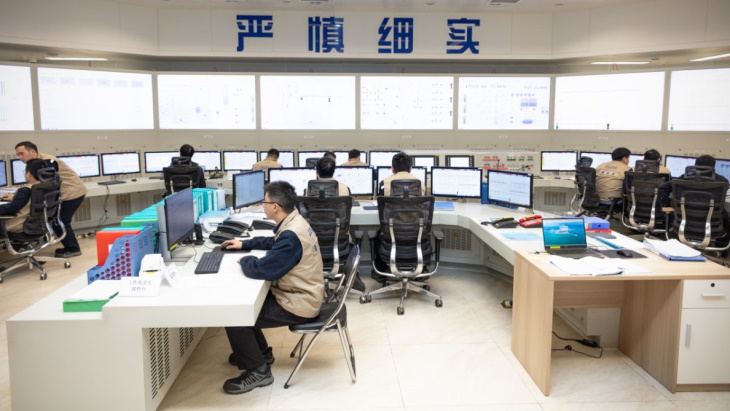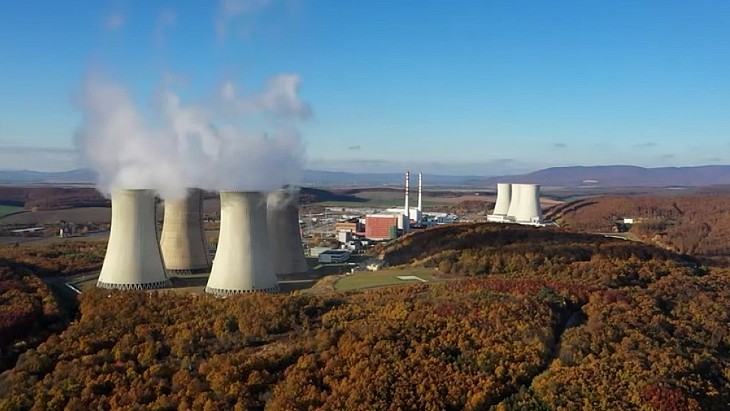The second stage of cold hydro testing of the primary circuit has begun at Mochovce nuclear power plant's unit 4 in Slovakia.
The cold hydro-testing of unit 4 began in early December, Slovenské elektrárne has said. Cold functional tests are carried out to confirm whether components and systems important to safety are properly installed and ready to operate in a cold condition. The main purpose of these tests is to verify the leak-tightness of the primary circuit and components - such as pressure vessels, pipelines and valves of both the nuclear and conventional islands.
Peter Andraško, deputy director of the Mochovce unit 4 project, said: "Following the successful completion of the inactive functional tests, we are entering the second phase of the inactive tests of the plant commissioning process. These are the so-called staged inactive testing programmes. The first of them is the cold hydrotest of the primary circuit."
Martin Mráz, director of completion and commissioning of systems at Mochovce unit 4, said: "A small revision, a hot hydro test and a large revision will follow, which will end the inactive tests. Once the fuel loading application is approved by the Nuclear Regulatory Authority of the Slovak Republic, we will load nuclear fuel into the reactor and start active tests."
Construction of the first two VVER-440 units at the four-unit Mochovce plant started in 1982. Work began on units 3 and 4 in 1986, but stalled in 1992. The first two reactors were completed and came into operation in 1998 and 1999, respectively, with a project to complete units 3 and 4 beginning ten years later.
Mochovce 3 entered commercial operation in October 2023 and unit 4's schedule has been to follow about two years behind unit 3. Each of the units will be able to provide 13% of Slovakia's electricity needs when operating at full capacity
Thursday, 2 January 2025
What are the main priorities, the key events and the likely big developments in new nuclear capacity in 2025? Here's an edited transcript of World Nuclear Association Director General Sama Bilbao y León's World Nuclear News podcast interview.
You can hear the full episode, including the review of 2024, below. The section looking ahead to 2025 begins from 31 minutes in.
What do you think are the main priorities for the year ahead?
One of the things that has been keeping me a little bit awake at night is to make sure that we, the global nuclear industry, make the most of the perfect alignment of the stars that we are seeing right now. We haven't seen this ever perhaps, or not in many decades. I keep saying this, but the time is truly now. If we as an industry don't get ready to invest in ourselves, whether it is the supply chain or workforce or everything else, then when will we do this? In the nuclear industry we are still a little bit conservative - we know what we've done for five decades and it's worked really well, so perhaps we are not quite ready to do something different.
So to me that's what we really need to do - to make the most of the moment and have some early wins, some early successes that carry on the momentum to deliver on all these promises.
In terms of planned events what do you think are the key ones?
It is going to be a very, very busy year. In every continent people are very interested in talking about nuclear. Of course, I think that everybody is looking at COP30 as an important event. This will be in November 2025 in Brazil. The reason I think COP30 will be particularly important is that countries will need to present their revised National Determined Contributions. This is where many countries need to assess whether what they have put in their future energy plans to reach their climate targets is realistic, and whether they are going to be able to do it. So COP30 will be very important. But there are many moments to COP30 and there are many regions and countries working hard for that.
I'm looking forward to India Energy Week, in February 2025. India is, of course, a huge country with a huge population, so what India does when it comes to energy is going to be very important. India has enormous plans for moving forward with nuclear, not only domestically, but also with a view to potential exports. So we are looking at a lot of nuclear focus in India in 2025, but there are also many other moments in the coming year.
This year will see the 50th World Nuclear Symposium in September in London. For us at World Nuclear Association, and for the global nuclear industry, I think this is going to be a very momentous occasion. We are looking forward to celebrating the 50th anniversary, but also setting the stage for the next 50 years and for what the nuclear industry is going to deliver. So that would be very important. There will also be our first World Nuclear Supply Chain conference that will take place in May in Warsaw in Poland, which is well timed because, as I said, it is essential that we as an industry get our act together. We are aiming for the conference to figure out what is needed from a policy point of view, from a financing point of view, from an industry point of view. We want to make sure this conference becomes a moment in which the industry can work together and figure out together what's needed to really develop the supply chain and the workforce.
Another key milestone will be World Nuclear University's Summer Institute, which goes from strength to strength, taking place in China in June and July. And, of course, in April we will have our World Nuclear Fuel Cycle conference, which this year will be in Montreal, Canada. That not only is a beautiful location, but clearly when we are talking about the fuel cycle in Canada, North America, this is going to be a very important moment given the global complexities in the front end of the nuclear fuel cycle.
And what new capacity can we look forward to?
I think in 2025 we will get a few additional Chinese reactors starting operation - the industry there is moving forward on many fronts in terms of large reactors and their first small modular reactor. We will also see Turkey starting up their first reactor and I think we will see Bangladesh, perhaps even this year producing [nuclear] electricity. So those are going to be big moments - it will be great to have these new countries in the global nuclear family.
I really hope that we see progress accelerating in the UK on new nuclear projects, both large reactors and SMRs. It is a very important market and it would set the right precedent so I think it's very important to make sure that all those projects are moving forward. There are many things happening across Europe - Poland, the Czech Republic, Romania, Hungary. These are projects that are actually happening, so we will see actual milestones being completed in the next year that will take us in the right direction.
A busy year ahead and that's without considering the impact of elections
Yes, I think that it's going to be very interesting to see in the year ahead in the US the new President Trump government's policies when it comes to, not only nuclear energy, but also the fuel cycle. I don't think that we expect wild changes, I think that in the US there is clear bipartisan support for nuclear energy so it may be just tweaking some of the things that they are doing. But clearly, we know that US policies will have a lot of impact everywhere else in the world, yes. (And referring to mention of elections due in Germany and Australia) Yes, there could be many interesting opportunities for nuclear, perhaps, in the coming years.
You can read about the review of 2024 from the same interview here:
Podcast: Nuclear energy's key moments in 2024
World Nuclear News









_59102.jpg)
_42897.jpg)
_44128.jpg)

_16184.jpg)
_63301.jpg)


.jpg)